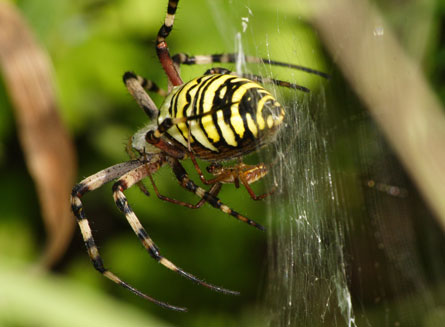Inbreeding isn’t worth dying for, even in a spider species where males routinely pay for sex with their lives.

Sex is never safe for males of the species Argiope bruennichi, one of Europe’s common orb-web spiders. In lab tests conducted by behavioral ecologists at the Zoological Institute and Museum of the University of Hamburg, males ended up as their mates’ lunch in about three trysts out of four.
But when researchers matched up siblings the cannibalism rate fell to about half, mostly because the males beat a hasty retreat, Klaas Welke and Hamburg colleague Jutta Schneider report online the week of April 19 in Biology Letters.
Males who found themselves paired with their sisters suspended relations after an average of six seconds, fast enough to improve their odds of escaping the female afterward. With an unrelated female, the average was about nine seconds.
The study suggests that males balance their chance of reproductive success against their risk of being eaten by adjusting how much time they spend mating.
Biologists have long recognized that mating with close relatives can lead to trouble, such as fewer or weaker offspring down the line. In species where females make greater investments in young or mate fewer times, biologists have predicted that females would be especially fussy about the risk of inbreeding.
But in Argiope bruennichi, males have more restrictions on mating. Each male has two sperm-delivery organs, or pedipalps, and they’re not reusable. During mating a bit breaks off, usually the tip, and acts as a partial plug in the female reproductive tract that makes insertion difficult for later males. Despite this barrier, females can still mate again, but males get only two shots.
“The males should be choosy,” Welke says.
And that’s how the experiment turned out. The researchers knew the family origin of each spider because they reared the arachnids from egg sacs collected in the wild. When the spiders grew up, researchers paired 45 females with sibling males and 46 with nonsiblings, and then compared reactions.
Just how males recognize their kin isn’t clear yet. But Welke notes that if spiderlings have the brain capacity to learn their siblings, they have months to do so. Mom lays the egg sac in summer, but youngsters hatch inside and stay cooped up until the next spring.
This finding of inbreeding avoidance in males intrigues Trine Bilde of Aarhus University in Denmark, who has studied the female side of inbreeding in spiders. It’s another twist in the tale of cannibals, which have proved quite informative to biologists. “It is interesting to study sexually cannibalistic species to understand how evolution can possibly favor self-sacrificing males,” she says.





